Chapter 17: Baroque Art
Key Notes
- Time Period: 1600–1700
- Culture, beliefs, and physical settings
- Baroque art can be found in New Spain.
- Baroque art still has a basis on classical formulas, but also has an interest in dynamic compositions and theatricality.
- Cultural interactions
- There are the beginnings of global commercial and artistic networks.
- Materials and Processes
- The period is dominated by an experimentation of visual elements, i.e., atmospheric perspective, a bold use of color, creative compositions, and an illusion of naturalism.
- Audience, functions, and patron
- There is a more pronounced identity and social status of the artist in society; the artist has more structured training opportunities.
- Theories and Interpretations
- Baroque art is studied in chronological order and by geographic region.
- There is a large body of primary source material housed in libraries and public institutions.
Historical Background
- In 1600, Rome was Europe's creative hub, especially at the popes' court.
- As a symbol of faith and the Church on earth, Saint Peter's was a Catholic Church campaign.
- By 1650, the French monarchs' growing power and influence in Paris and Versailles had moved the art world to France.
- While Rome retained its attractiveness as the guardian of ancient and Renaissance treasures, France became the focus of contemporary art and invention until World War II.
- In 1648, the Thirty Years' War was the most significant political event of the seventeenth century.
- The Thirty Years' War featured political, economic, and social aspects as well as a Catholic Counter-Reformation.
- For the rest of the century, central Europe's economy and art were crippled by the conflict.
- The Protestant Reformation was upheld by the Counter-Reformation.
- Catholics revered pictures and were motivated to make new ones, whereas Protestants destroyed them.
- Protestants mocked saints, while Catholics venerated them.
- Protestants downplayed miracles; Catholics made them tangible and real like Saint Teresa's Ecstasy.
Patronage and Artistic Life
- In the seventeenth century, the Catholic Church was the largest source of artistic commissions, followed by monarchy and despotic regimes.
- Huge cathedrals and castles required expensive paintings to fill their huge areas.
- Many Baroque painters, such as Rubens and Bernini, were deeply devout and committed to both their work and their religion.
- Pope Urban VIII, for example, supported Bernini's greatest work.
Baroque Architecture
- The Baroque emphasizes landscape architecture.
- Starting with Versailles and continuing throughout the seventeenth century, palaces are envisioned as the main component of an ensemble with gardens ingeniously organized to complement the structures they framed.
- Long-term opinions matter.
- Key windows are observation stations where gardens are ingeniously arranged to symbolize man's influence over his surroundings.
- The views gaze along long avenues with grass and trees, generally ending in a monument or fountain.
- It's meant to inspire limitlessness.
- Movement drives baroque architecture.
- Façades undulate, alternating sun-catching pilasters with symmetrical shadow voids.
- Wave-like shapes highlight the entry in the façade's center.
- To emphasize their significance, doorways have pediments or tympana.
- Borromini's most experimental structures use concave and convex forms carefully.
- Interiors are elaborately constructed to blend all the arts; painting and sculpture serve the architectural components in a synchronized ensemble.
- Baroque structures aspire for dramatic unity.
- Baroque architecture is grand and ornate.
- The Baroque style displays its benefactors' imperial or papal authority and riches.
- Buildings are built on high sites with artistically carved stairs that pour out toward the viewer and change direction and perspective as they ascend.
➼ Santa Maria della Vittoria
Details
- By Carlo Maderno
- 1605–1620
- Found in Rome
Form
- First story: six Ionic pilasters; emphasis placed on center of façade.
- Round and triangular pediments; broken pediments; swags and scrollwork.
Function: Catholic church, originally dedicated to Saint Paul.
Context
- Rededicated to the Virgin Mary in gratitude for a military victory in Bohemia in 1620.
- The Turkish standards captured in the Siege of Vienna in 1683 are on display.
- Single wide nave
- One of the side chapels houses Bernini’s Ecstasy of Saint Teresa, with a window added to illuminate the sculptural group.
Image
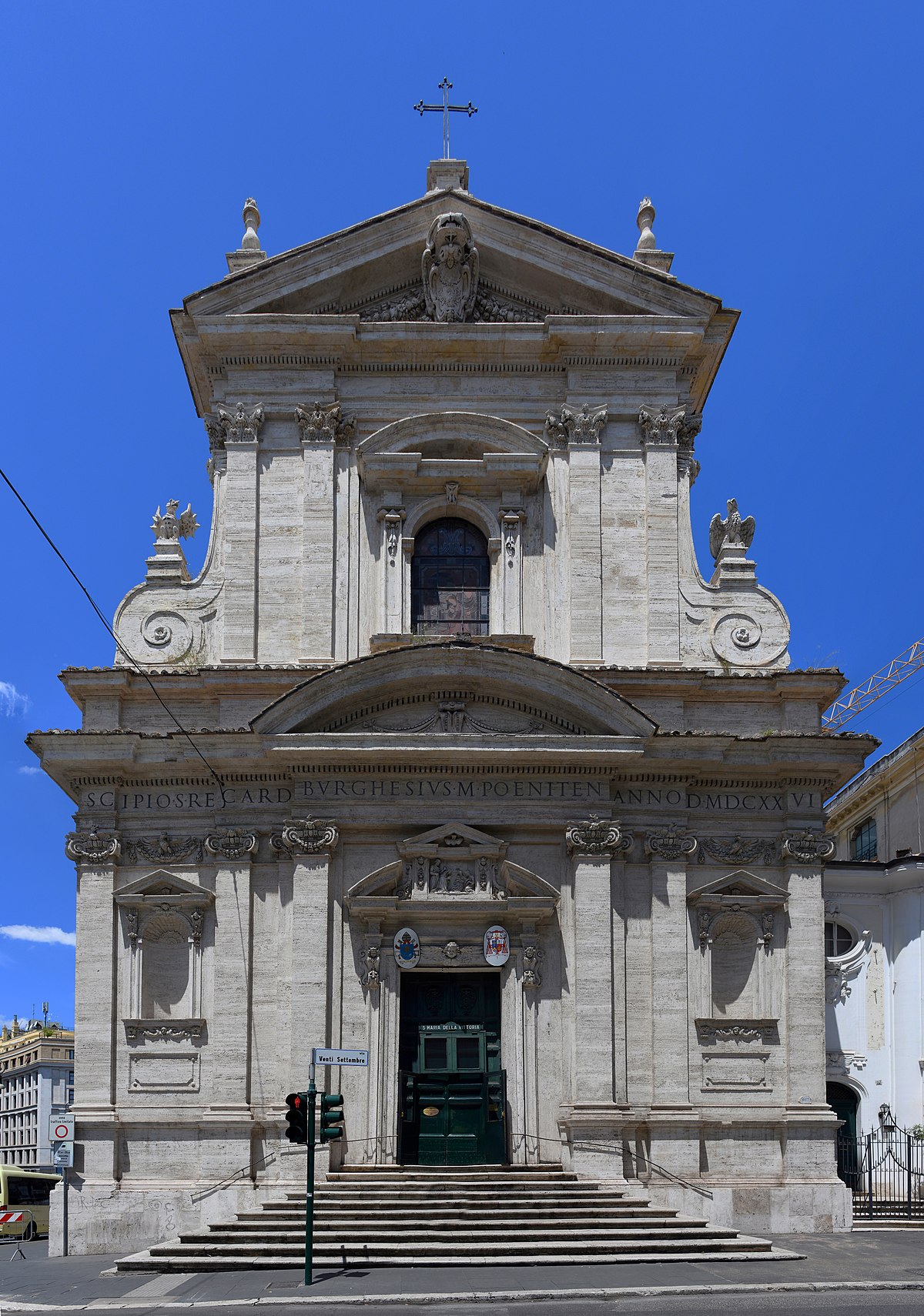
➼ Saint Charles of the Four Fountains
Details
- By Francesco Borromini
- 1638–1646
- Made of stone and stucco
- Found in Rome
Form: So named because it is on a street intersection in Rome with four fountains.
Exterior
- Unusually small site.
- The building is designed with alternating convex and concave patterns and undulating volumes in both the ground plan and on the façade.
- The façade higher than the rest of the building.
Interior
- The interior side chapels merge into a central space.
- The interior dome is oval shaped and coffered.
- The dome has an interconnection of different shapes that fit together seamlessly; they illustrate the Baroque admiration for multiplicity that resolves into a unified space.
- The walls are treated sculpturally; Baroque drama and complexity.
- Borromini worked in shades of white, avoided colors used in many other Baroque buildings.
Function: It was built as part of a complex of monastic buildings for the Spanish Trinitarians, an order of religious dedicated to freeing Christian slaves.
Context
- Sculptures of Trinitarian saints are placed on the façade.
- Medallion on façade once held a fresco of the Trinity.
- Borromini worked on the building for free, giving him more artistic license.
Images
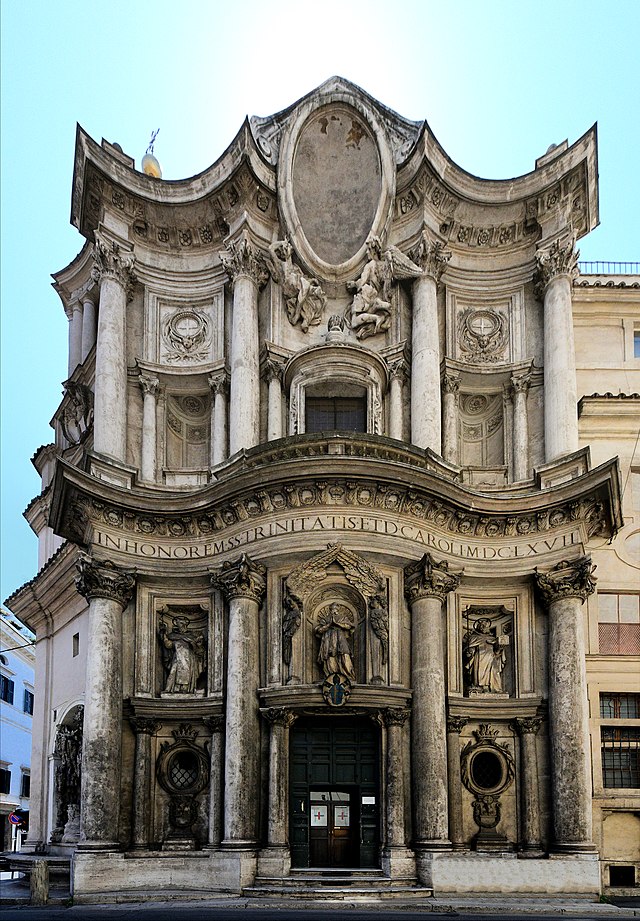
➼ Versailles
Details
- By Louis Le Vau and Jules Hardouin-Mansart
- Begun 1669
- Made of masonry, stone, wood, iron, and gold leaf; gardens
- Found in Versailles, France
Function
- This is the palace of King Louis XIV and subsequent kings and their courts.
- The palace expresses the idea of the absolute monarch; the massive scale of the project is indicative of the massive power of the king.
Form and History
- Louis XIV reorganized and remodeled an existing hunting lodge into an elaborate palace.
- The center of the building is Louis XIV’s bedroom, or audience chamber, from which all aspects of the design radiate like rays from the sun (hence Louis’ sobriquet the Sun King).
- The building is centered in a vast garden and town complex that radiated from it.
- There is a subdued exterior decoration on the façade; the undulation of projecting members is understated.
Hall of Mirrors
- 240 feet long, facing the garden façade.
- Barrel-vaulted painted ceiling (paintings stress the military victories of Louis XIV; rooms that flank the Hall of Mirrors are thematically related, one of Peace and the other War).
- Light comes in from one side and ricochets off large panes of glass, the largest that could be made at the time.
- This is an example of a use of flickering light in an architectural setting.
- Mirrors were among the most expensive items manufactured in the seventeenth century—the Hall of Mirrors is an extravagant display of wealth.
- Mirrors were made exclusively in Venice at the time; workers had to be imported from Venice to make the mirrors, which conformed to the dictates that the decorations at Versailles had to be made in France.
- Hall of Mirrors used for court and state functions: embassies, births, and marriages were celebrated in this room.
- Subsequent history:
- Used by Bismarck to declare William I as German emperor after the defeat of the French in the Franco-Prussian War in 1871.
- Used reciprocally by the French after the defeat of the Germans in World War I to sign the Treaty of Versailles in 1919.
Gardens
- Classically and harmoniously arranged.
- Formal gardens near the palace; more wooded and less elaborate plantings farther from the palace.
- Baroque characteristics:
- Large size.
- Long vistas.
- Terminal views in fountains and statuary.
- Geometric plantings show control of nature.
- A mile-long canal crossed by another canal forms the main axis of the gardens; linked to the rising sun over the palace.
- Only the fountains near the palace were turned on all the time; others were turned on only when the king progressed through the gardens.
- Illustrates the belief that humans can organize and control nature to make a more refined experience.
Images
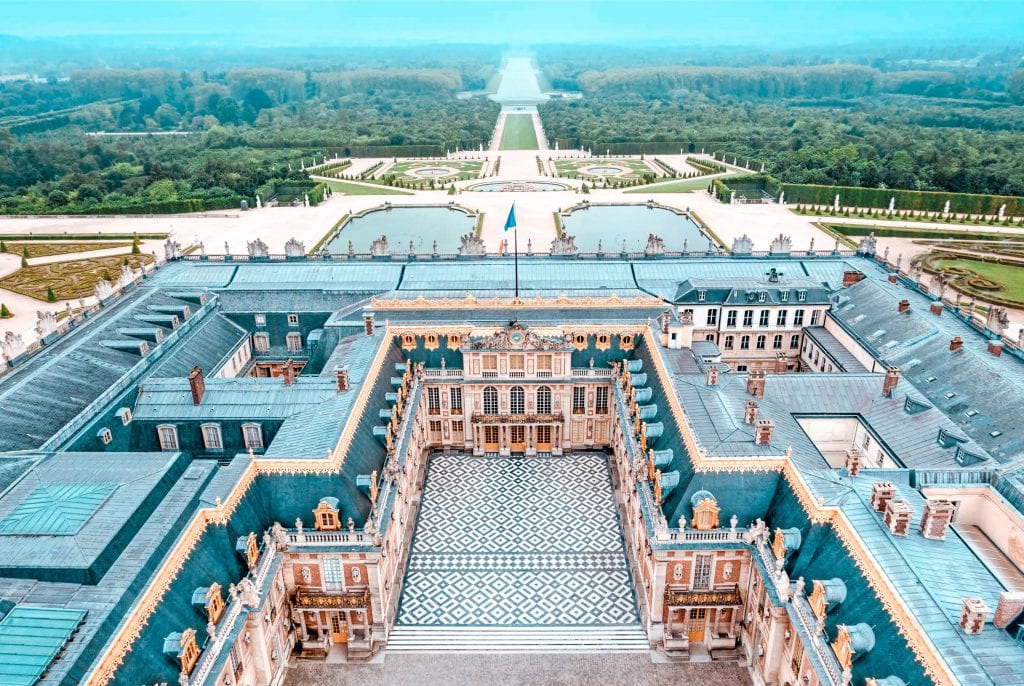

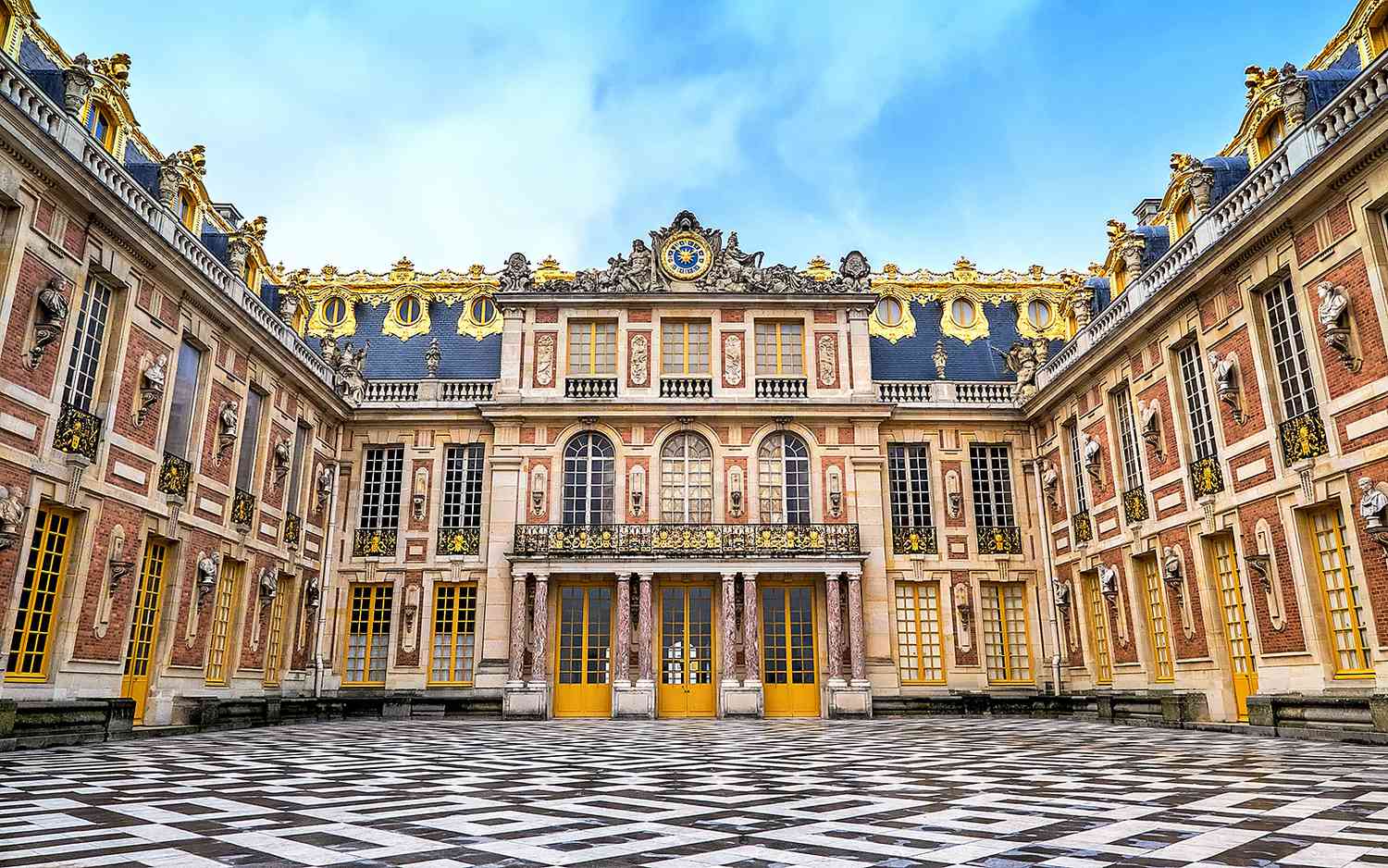
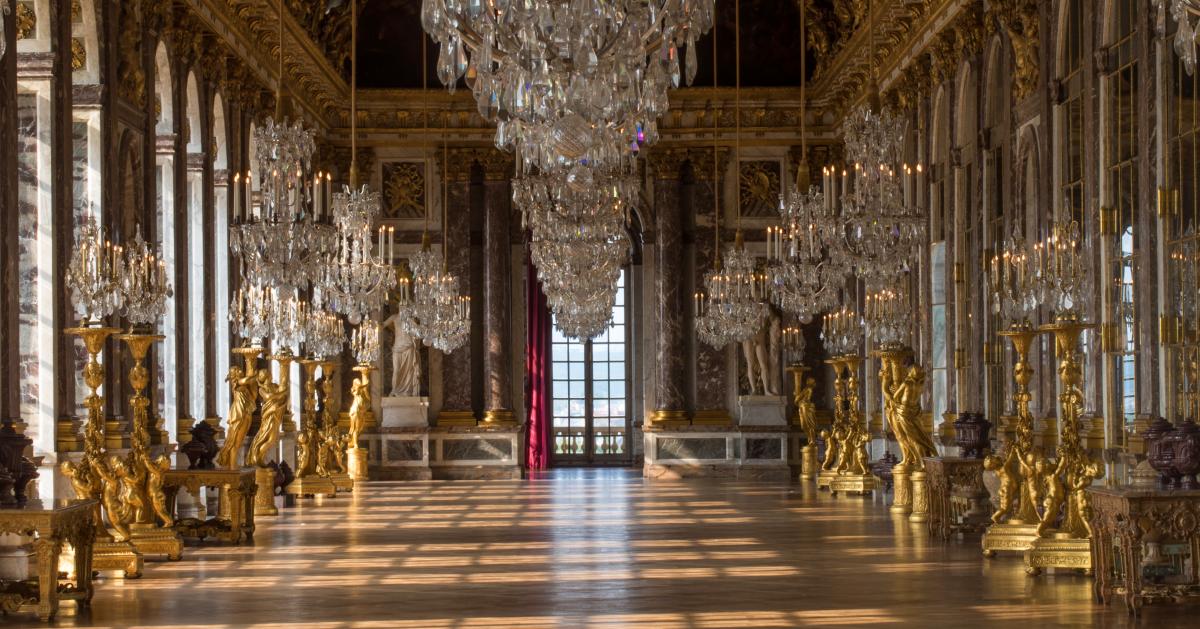
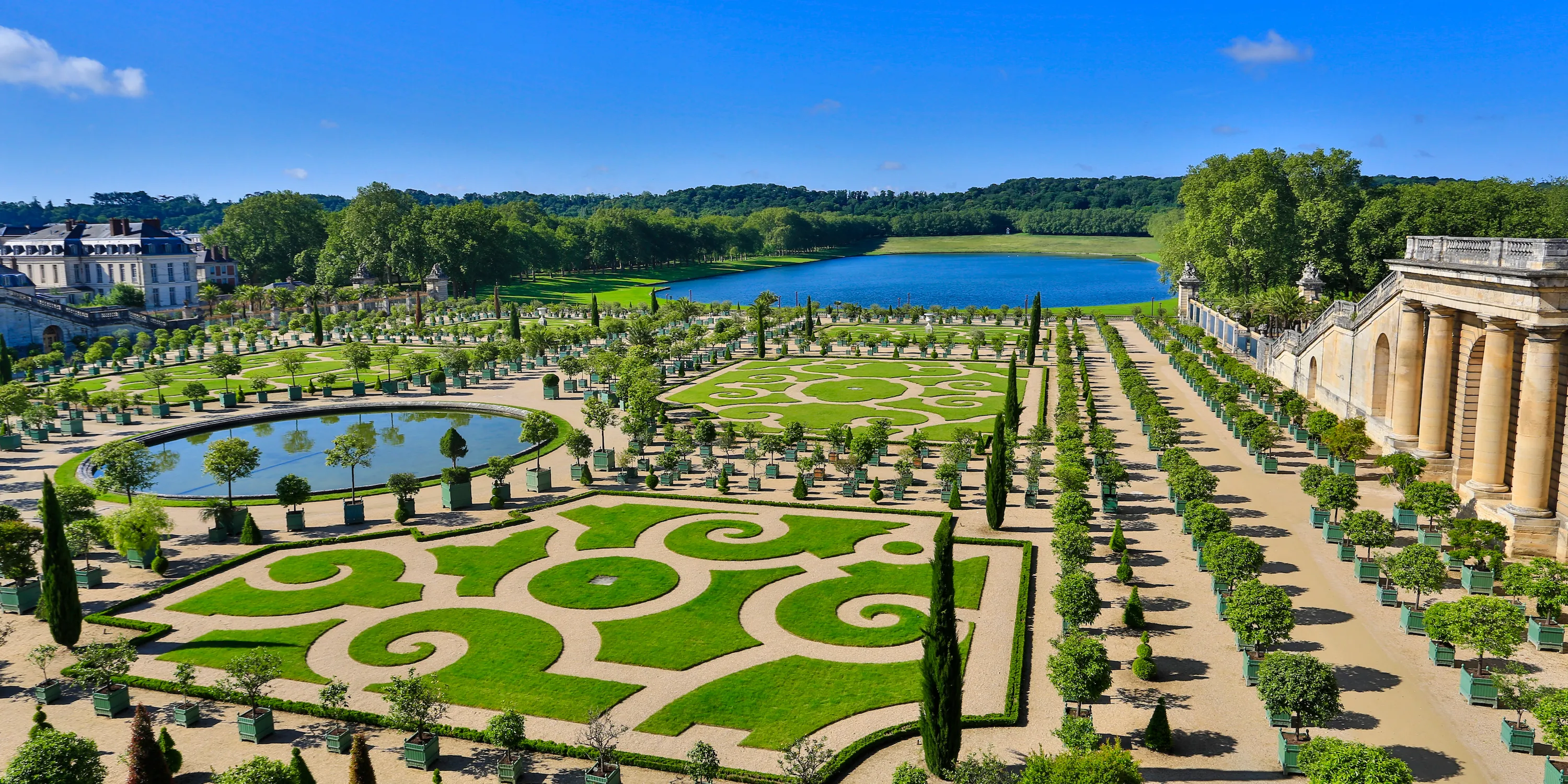
Baroque Painting and Sculpture
- The Baroque period saw the exploration of themes that had their origins in the Renaissance but had been viewed as too simple for serious painting.
- The seventeenth century saw unparalleled success for these genres, including still life, genre, and landscape painting.
- Even great artists like Rembrandt and Rubens produced landscapes and genre subjects even if religious and historical paintings were still regarded as the finest form of expression.
- The Dutch school excelled at still life paintings.
- Genre painting: painting in which scenes of everyday life are depicted
- Still life: a painting of a grouping of inanimate objects, such as flowers or fruit
- Landscapes and still lifes serve to convey a deeper meaning rather than existing for their own sake.
- Vanitas themes, which emphasize the fleeting nature of life and the foolishness of human pride, are common in still life paintings.
- Vanitas: a theme in still life painting that stresses the brevity of life and the folly of human vanity
- Little characters in the foreground are acting out a Biblical or mythological passage in wide open settings.
- The allegorical commentary on a current or historical subject was common in genre paintings.
- Landscapes were never actual views of a location; rather, they were created in a studio using field sketches.
- The artist has complete freedom to combine structures from one location with trees from another.
- In order to create an artistic statement, landscape painters felt compelled to look beyond the obvious and into a world of invention that depends on the skillful blending of dissimilar components.
- Even the best painters of the century experimented with tenebrism due to how fascinating it was to artists.
- Tenebroso/Tenebrism: a dramatic dark and light contrast in a painting
- Baroque artists, including painters, sculptors, and builders, became renowned for their mastery of light and shadow.
- Northern artists were experts in impasto brushwork, which produced a sensation of spontaneity through a lively use of visible brushwork.
- Impasto: a thick and very visible application of paint on a painting surface
- The texture of surfaces was similarly moved by sculptors by variably polishing or abrading surfaces.
- Caravaggio was one of many painters that used expressive movement in their work. Even in what appears to be a straightforward portrait, figures are vividly depicted.
- Key lighting effects include offstage sources illuminating specific characters in tenebroso, a dramatic contrast of dark and light.
- Colors may both describe and evoke feelings.
- The Venetian Renaissance serves as an inspiration for Caravaggio, Rubens, and his group of adherents, known as Rubénistes.
- Naturalists disapprove of what they consider to be the Mannerisms' contortions and artificiality.
- Like other forms of art, movement was emphasized in baroque sculpture.
- Mouths open, figures are frozen in mid-motion, and the flesh of one figure is giving to the touch of another.
- Large works, especially those by Bernini, were frequently intended to be positioned in the center of the floor or a short distance from a wall and be viewed from all sides.
- Sculptors use negative space, creating substantial gaps in their creations so the observer can consider a variety of viewpoints.
- Human skin is polished to a high shine, angel wings are displayed with a feathery touch, and animal skins have a coarser feel.
- The most notable works of the Greek Hellenistic era served as inspiration for baroque sculptors.
➼ Ecstasy of Saint Teresa
Details
- By Gian Lorenzo Bernini
- 1647–1652
- Italian Baroque Art
- Made of marble, stucco and gilt bronze
- Found in Santa Maria della Vittoria, Rome
Form
- Marble is handled in a tactile way to reveal textures: skin is high gloss, feathers of angel are rougher, drapery is animated and fluid, clouds are roughly cut.
- Figures seem to float in space; the rays of God’s light symbolically illuminate the scene from behind.
- Natural light is redirected onto the sculpture from a window hidden above the work.
- The work captures a moment in time—a characteristic of Baroque art.
Patronage: Stage-like setting with the patrons, members of the Cornaro family, sitting in theater boxes looking on and commenting.
Function and Context
- Saint Teresa was canonized in 1622; a new saint at the time.
- This is a sculptural interpretation of Saint Teresa’s diary writings, in which she tells of her visions of God, many involving an angel descending with an arrow and plunging it into her.
- Saint Teresa’s pose suggests sexual exhaustion, a feeling that is consistent with her description of spiritual ecstasy in her diary entries.
- This is a Counter-Reformation work that illustrates the use of images to increase piety and devotion among the Catholic faithful.
- It is located inside Santa Maria della Vittoria.
- Cf. Visionary experience depicted in Lintel 25, Yaxchilán.
Image
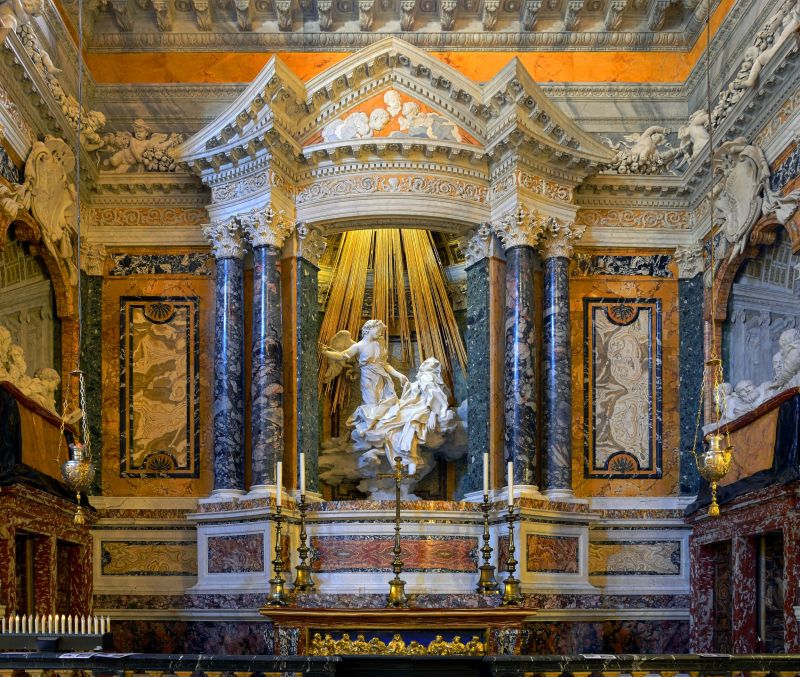
➼ Calling of Saint Matthew
Details
- By Caravaggio
- 1597–1601
- Italian Baroque Art
- Made of oil on canvas
- Found in San Luigi dei Francesi, Rome
Function and Patronage: One of three paintings illustrating the life of Saint Matthew in a chapel dedicated to him by the Contarelli family.
Form
- Diagonal shaft of light points directly to Saint Matthew, who points to himself as if unsure that Christ would select him.
- Light coming in from two sources on the right creates a tenebroso effect on the figures.
- Christ’s pose is the inverse of Adam’s on the Sistine Ceiling.
- Only a slight suggestion of a halo on Christ’s head indicates sanctity of the scene.
- Foppishly dressed figures wear cutting-edge Baroque fashion.
- Figures placed on a shallow stage.
- Sensual figures, everyday people.
- Naturalist approach to the Baroque.
Context
- Matthew was a tax collector; hence he is seated at a table with coins being counted.
- Story taken from Matthew 9:9: “As Jesus went on from there, he saw a man named Matthew sitting at the tax collector’s booth. ‘Follow me,’ he told him, and Matthew got up and followed him.”
- Two figures on the left are so concerned with counting the money they do not even notice Christ’s arrival; symbolically their inattention (and by implication, everyone else’s) to Christ deprives them of the opportunity he offers: eternal life.
- Jesuit influence on Counter-Reformation Baroque art; the sensual or physical expression of faith as expressed in Saint Ignatius’s Spiritual Exercises.
Image
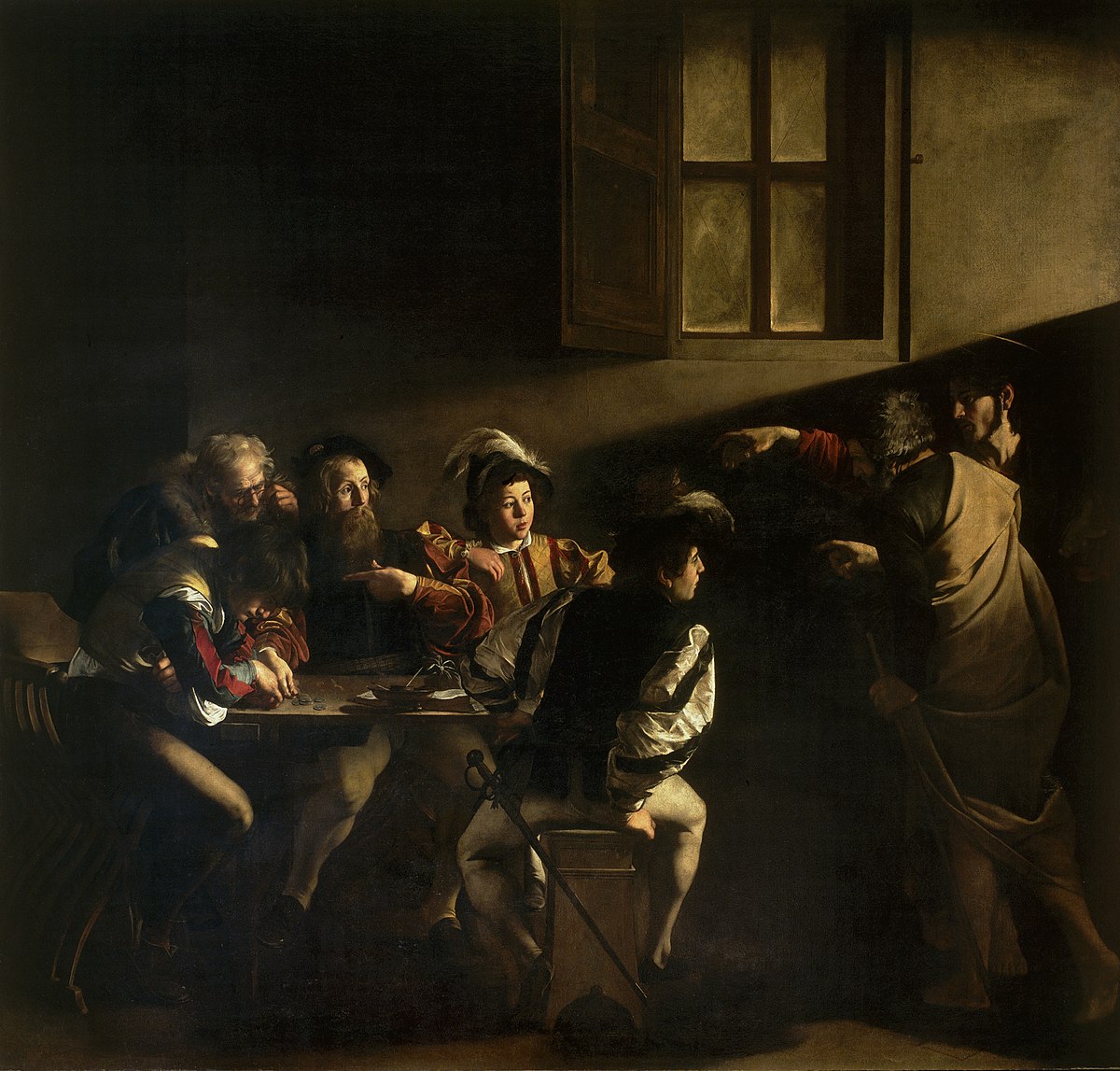
➼ Triumph of the Name of Jesus
Details
- By Giovanni Battista Gaulli
- 1676–1679
- Italian Baroque Art
- Made of fresco and stucco
- Found in Il Gesù, Rome
Form and Content
- On the ceiling in the main nave of Il Gesù, Rome
- In the center is the monogram of Jesus, IHS, in a brilliant sea of golden color.
- Figures tumble below the name; some are carved in stucco and enhance the three-dimensional effect.
- Some cast long shadows across the barrel vault.
- Some painted figures are not stucco, but maintain a vibrant three-dimensional illusion.
- It is as if the ceiling were opened to the sky and the figures are spiraling around Jesus’s name.
- Depicted in the center are holy men and women.
- Around the rim are priests, soldiers, noblemen, and the Magi.
- Allegories of avarice, simony, heresy, and vanity occupy the lowest registers.
- Di sotto in sù: a type of ceiling painting in which the figures seem to be hovering above the viewers, often looking down at us
Function
- A Last Judgment scene, placed over the barrel vault of the nave; cf. Last Judgment scenes placed on the walls of chapels.
- Message to the faithful: the damned are cast into hell; the saved rise heavenward.
Context
- Inspired by Saint Paul’s epistle to the Philippians 2:10: “That at the name of Jesus every knee should bow, of things in heaven, and things in earth, and things under the earth.”
- There is the influence of Bernini’s dramatic emotionalism in the style; Gaulli was Bernini’s pupil.
Image
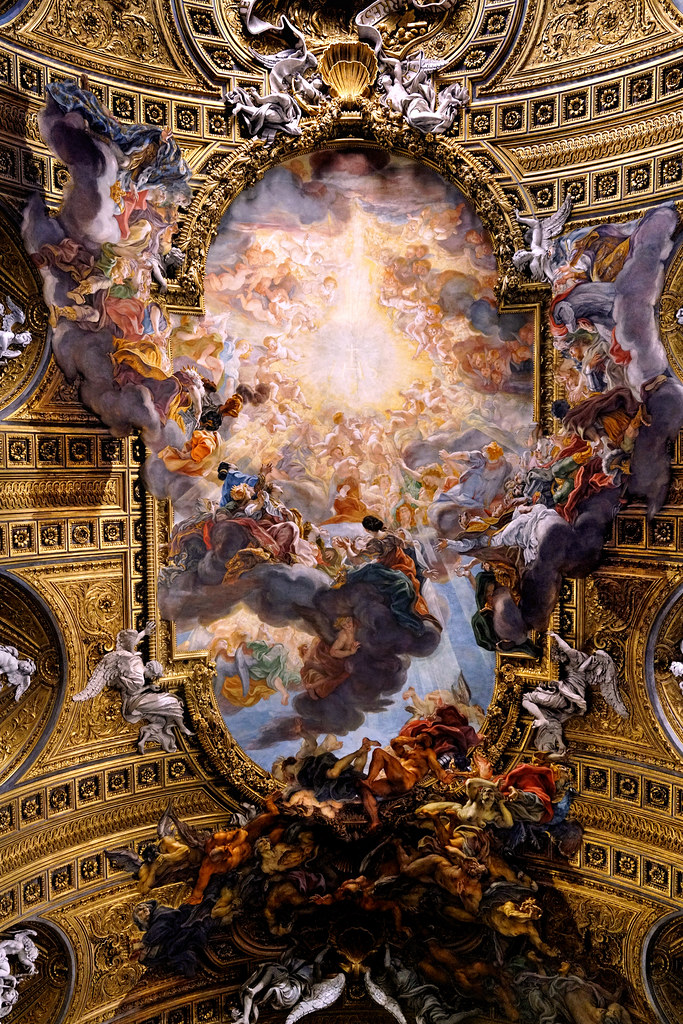
➼ Las Meninas
Details
- By Diego Velázquez
- 1656
- Spanish Baroque Art
- Made of oil in canvas
- Found in Prado, Madrid
Content
- Portrait of the artist in his studio at work; he steps back from his very large canvas and looks at the viewer.
- Central is the Infanta Margharita of Spain with her meninas (attendants), a dog, a dwarf, and a midget. Behind are two chaperones in half-shadow. In the doorway is perhaps José Nieto, who was head of the queen’s tapestry works (hence his hand on a curtain).
- The king and queen appear in a mirror. But what is the mirror reflecting?
- Velázquez’s canvas?
- The king and queen perhaps standing in the viewer’s space—is this why people have turned around?
- Or is it reflecting a painting of the king and queen on the far wall of the room?
- What is the painter painting?
- The royal family?
- The Infanta?
- A painting of this painting?
- Us?
- Ultimately, there is no answer, which expresses the Baroque fascination with exploring reality.
Form
- Alternating darks and lights draw the viewer deeper into the canvas; the mirror simultaneously reflects out into the viewer’s space.
- Dappled effect of light on shimmering surfaces.
- Painterly brushstrokes seen in the sleeves of the Infanta and the hands of the artist.
Function: Painting originally hung in King Philip IV’s study.
Context
- Velázquez wears the cross of the Royal Order of Santiago, which elevated him to knighthood; this work seeks to establish painting as a noble occupation.
- Paintings on the back wall depict Minerva, goddess of wisdom and patroness of the arts.
Image
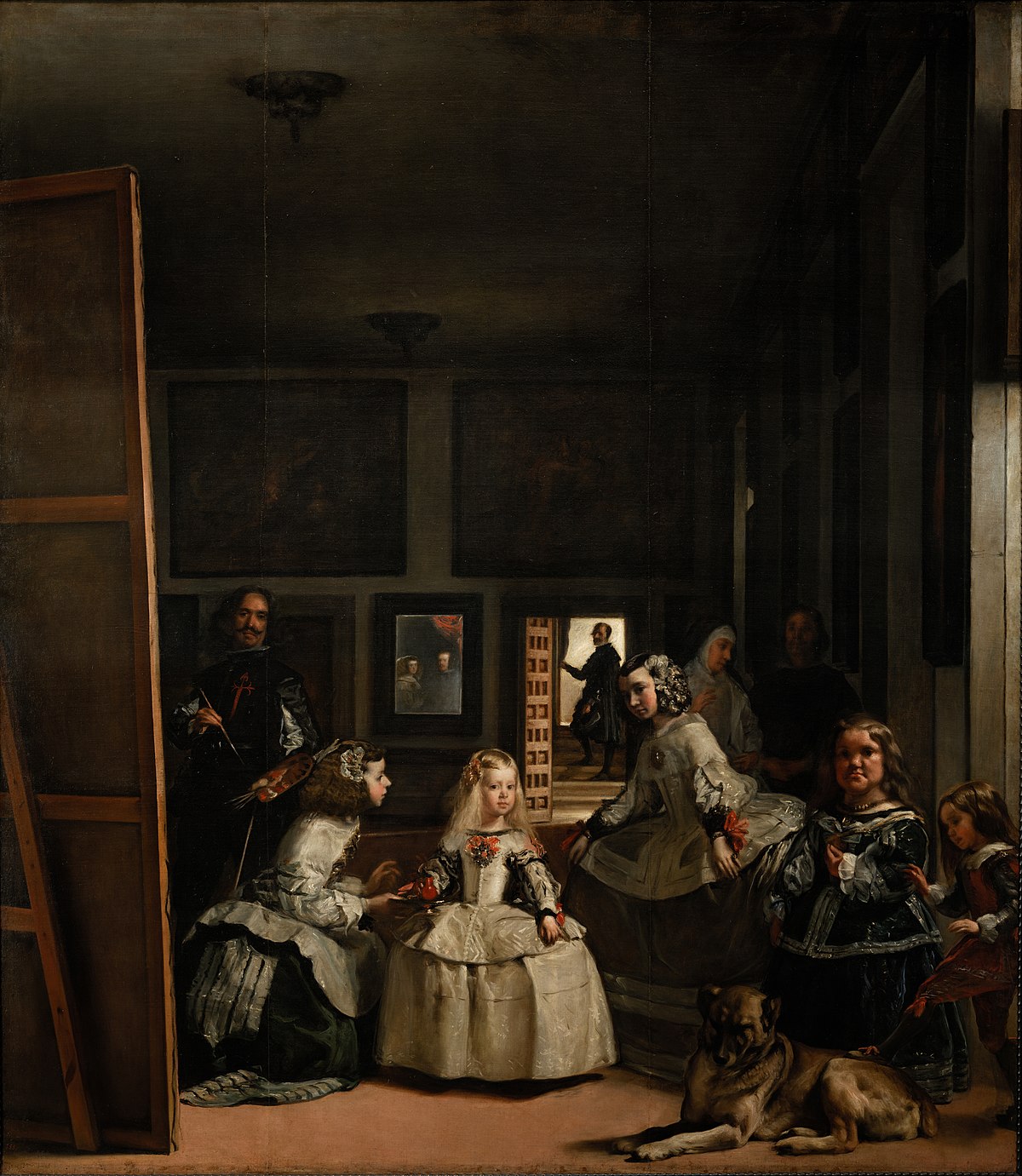
➼ Marie de’ Medici Cycle
Details
- By Peter Paul Rubens
- 1621-1625
- Flemish Baroque Art
- Made of oil in canvas
- Found in Louvre, Paris
Form
- Heroic gestures, demonstrative spiraling figures.
- Mellow intensity of color, inspired by Titian and Caravaggio.
- Sumptuous full-fleshed women.
- Splendid costumes suggest an opulent theatrical production.
- Allegories assist in telling the story and mix freely with historical people.
Function and Context
- 24 huge historical paintings allegorically retelling the life of Marie de’ Medici, queen of France, wife of King Henry IV; the series also contains three portraits.
- Commissioned by Marie de’ Medici, at the time the widow of Henry IV.
- The series was placed in Marie de’ Medici’s home in Paris, the Luxembourg Palace.
Henri IV Receives the Portrait of Marie de’ Medici
- Henry IV is smitten by the portrait of his intended; the portrait is the center of a swirling composition.
- The portrait is held by Cupid (the god of love) and Hymen (the god of marriage).
- Mythological gods Jupiter (symbolized by an eagle) and Juno (symbolized by a peacock) look down from below; they are symbolic of marital harmony. They express their support.
- Royalty was considered demigods; the approval of mythological gods is in concert with their beliefs about themselves.
- This represents the tradition of portraits being exchanged before the marriage.
- They were actually married by proxy in 1600.
- Behind Henry is the personification of France:
- France is a female figure with a masculine helmet and manly legs.
- She whispers to Henry to choose love over war.
Image
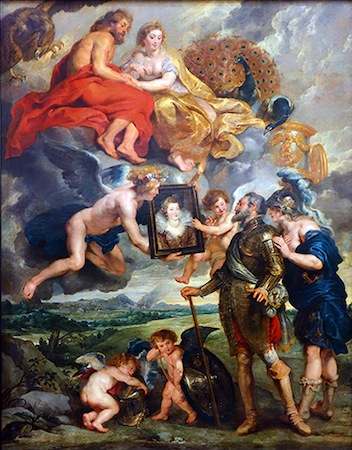
➼ Self-Portrait with Saskia
Details
- By Rembrandt
- 1636
- Dutch Baroque Art
- Made of oil in canvas
- Found in Art Institute of Chicago, Chicago, Illinois
Content
- Rembrandt is seen drawing or perhaps making an etching.
- Saskia is seated deeper into the work, but is very noticeable because she is portrayed with a lighter touch.
Function: Not for general sale but for private purposes.
Context
- The scene depicts the 30-year-old Rembrandt with his new bride.
- This is the only image of Rembrandt with his wife together in an etching.
- Images of Saskia are abundant in Rembrandt’s output; she was a source of inspiration for him.
- Marital harmony; Saskia as a muse who inspires him.
- Characteristic of Rembrandt: they are wearing fanciful, not contemporary, dress.
- Saskia was the mother of four.
- Rembrandt’s self-portraits included 50 paintings, 32 etchings, and 7 drawings.
Image
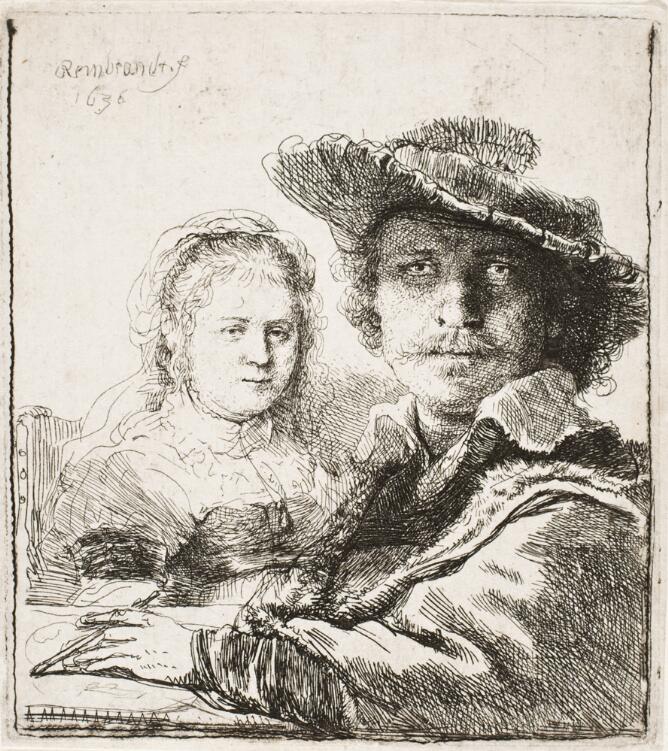
➼ Woman Holding a Balance
Details
- By Johannes Vermeer
- c. 1664
- Dutch Baroque Art
- Made of oil in canvas
- Found in National Gallery of Art, Washington
Form and Content
- Light enters from the left, illuminating the figures and warmly highlighting textures and surfaces: the woman’s garments, wooden table, marble checkerboard floor, jewelry, the painting, etc.
- A moment in time: stillness and timelessness.
- The woman is dressed in fine, fur-trimmed clothing.
- Geometric lines focus on a central point at the pivot of the balance.
- The figure seems unaware of the viewer’s presence.
- Her pensive stillness suggests she may be weighing something more profound than jewelry.
Context
- A small number of Vermeer works are in existence.
- Except for two landscapes, Vermeer’s works portray intimate scenes in the interior of Dutch homes.
- The viewer looks into a private world in which seemingly small gestures take on a significance greater than what first appears.
- A family member may have posed for the painting, perhaps Vermeer’s wife, Caterina.
Theories
- Is it a genre scene or an allegory? Or both?
- A moment of weighing and judging.
- In the background is a painting of the Last Judgment, a time of weighing souls:
- The woman is at a midpoint between earthly jewels and spiritual goals such as meditation and temperance.
- The balance (scale) has nothing in it; pearls and coins on the table waiting to be measured; may be symbolic of a balanced state of mind.
- The balancing reference perhaps relates to the unborn child.
- This is Catholic subject matter in a Protestant country; Vermeer and his family were Catholic.
- Vanitas painting: gold should not be a false allure.
- Vermeer may have used a camera obscura.
Image
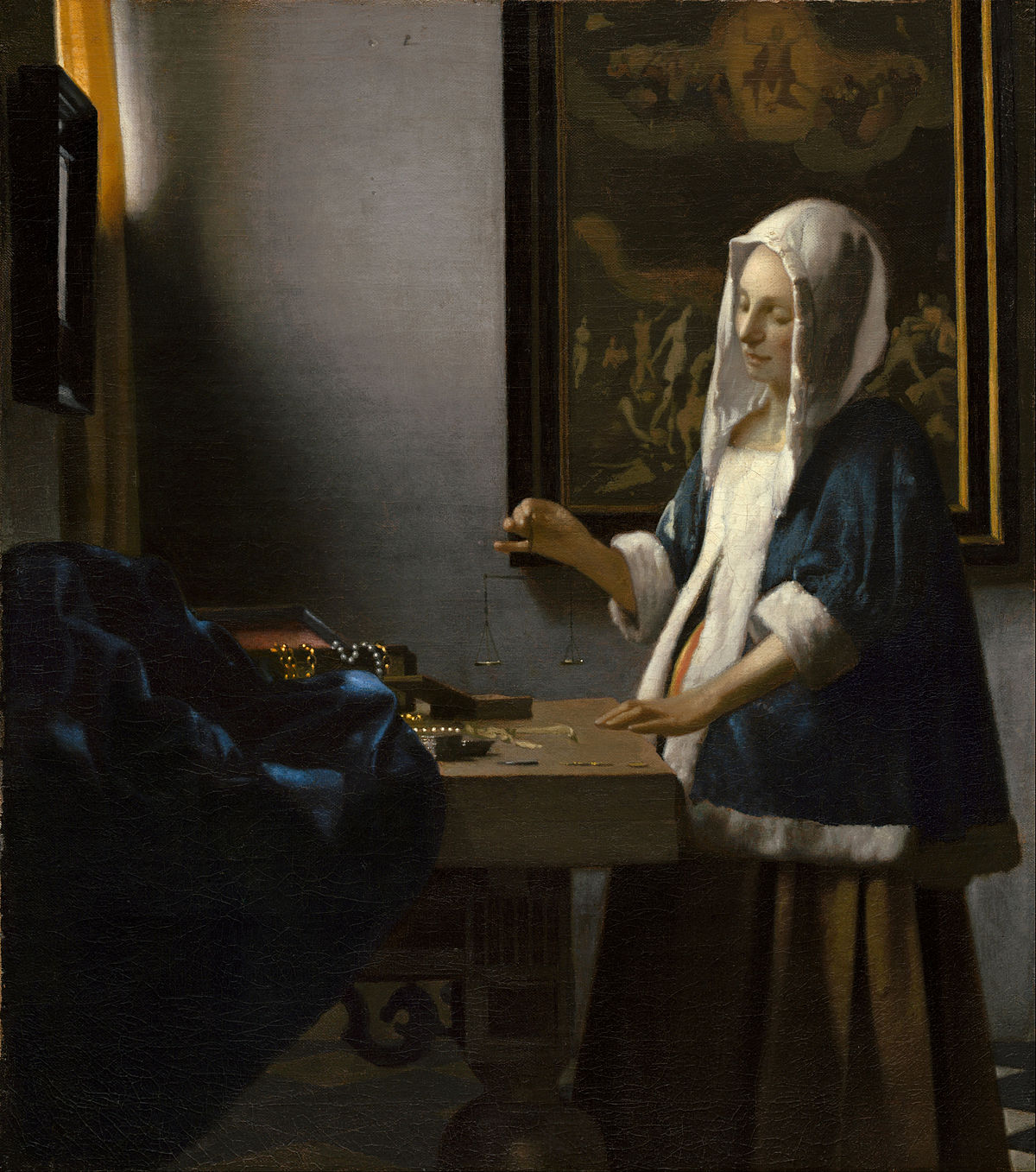
➼ Fruit and Insects
Details
- By Rachel Ruysch
- c. 1664
- Dutch Baroque Art
- Made of oil in wood
- Found in Uffizi, Florence
Form
- Asymmetrical, artful arrangement.
- A finely detailed illustration of natural objects in a rural setting.
Content
- Not a depiction of actual flowers, but a construct of perfect specimens all in bloom at the same time.
- The artist probably used illustrations in botany textbooks as a basis for the painting.
- Wheat and grapes juxtaposed: may have been a reference to the Eucharist.
Context
- The artist’s father was a professor of anatomy and botany as well as an amateur painter.
- The artist produced a number of such still lifes in woodland settings.
- Parallels Dutch interest in botany, and the growing of flowers for decorative and medicinal purposes.
- Flowers were symbols of wealth and status.
Image
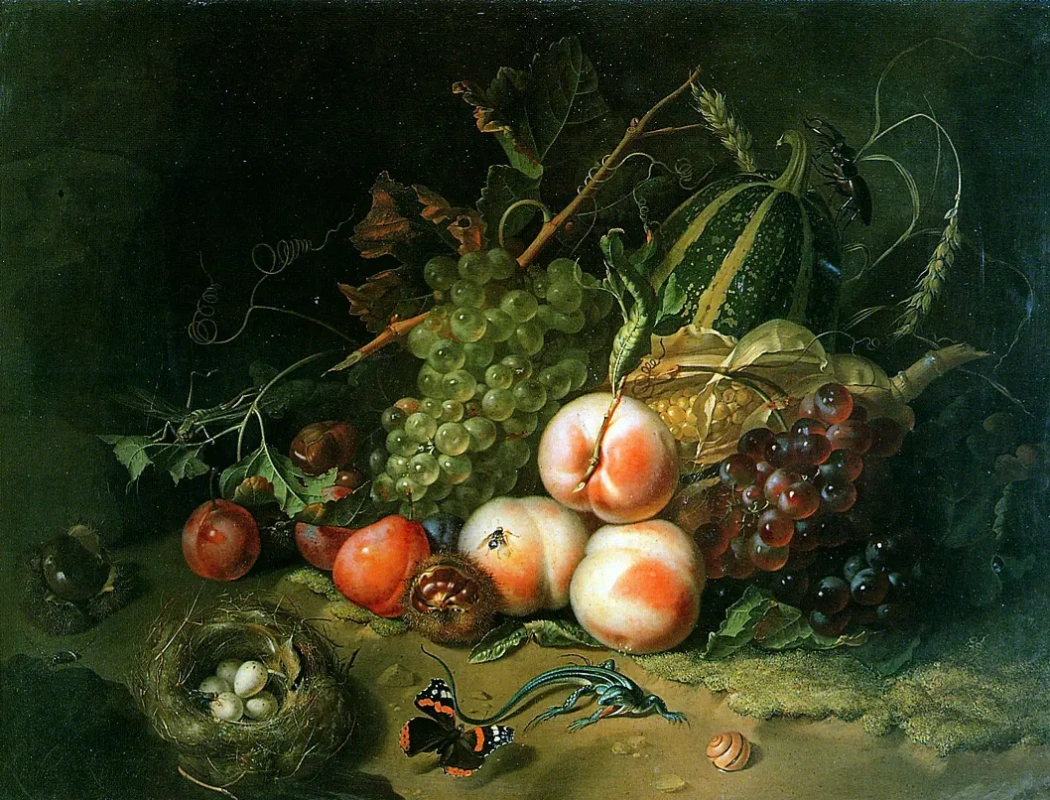
Chapter 18: Art of New Spain: Spanish Colonies in the Americas